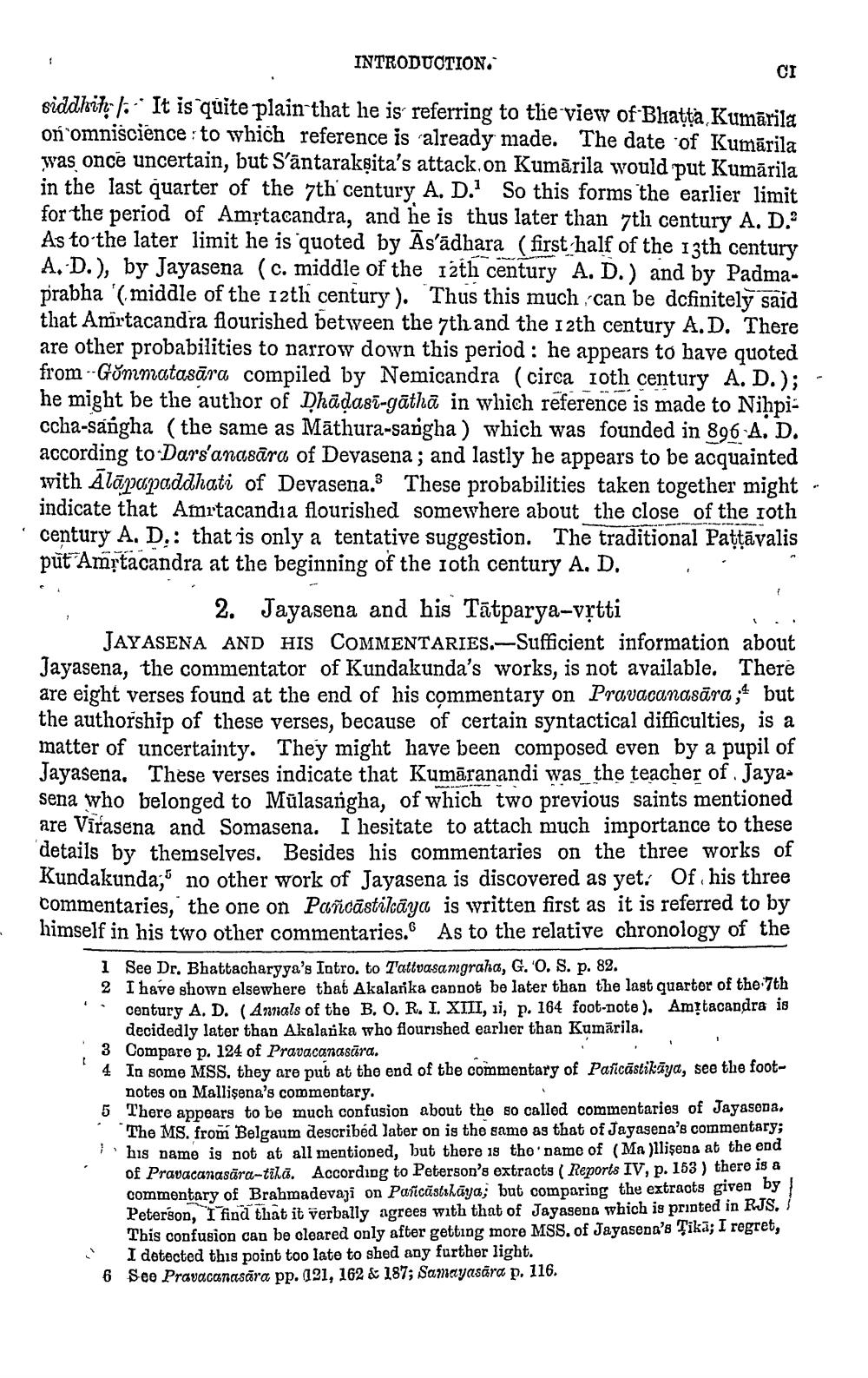________________
INTRODUCTION
CI
siddhit l. It is quite plain that he is referring to the view of Bhatta Kumārila on omniscience: to which reference is already made. The date of Kumārila was once uncertain, but S'ântarakṣita's attack on Kumārila would put Kumārila in the last quarter of the 7th century A. D.' So this forms the earlier limit for the period of Amrtacandra, and he is thus later than 7th century A. D. As to the later limit he is quoted by As'adhara (first half of the 13th century A. D.), by Jayasena (c. middle of the 12th century A. D.) and by Padmaprabha '( middle of the 12th century). Thus this much, can be definitely said that Amrtacandra flourished between the 7th and the 12th century A.D. There are other probabilities to narrow down this period : he appears to have quoted from --Gởnnatasāra compiled by Nemicandra (circa 10th century A. D.); - he might be the author of Dhādasi-gātha in which reference is made to Nihpiccha-sangha (the same as Māthura-sargha) which was founded in 896 A. D. according to Dars'anasāra of Devasena; and lastly he appears to be acquainted with Ālāpapaddhati of Devasena. These probabilities taken together might - indicate that Amrtacandia flourished somewhere about the close of the roth century A. D.: that is only a tentative suggestion. The traditional Pattāvalis put Amrtacandra at the beginning of the roth century A. D.
2. Jayasena and his Tātparya-vitti JAYASENA AND HIS COMMENTARIES.-Sufficient information about Jayasena, the commentator of Kundakunda's works, is not available. There are eight verses found at the end of his commentary on Pravacanasāra ;t but the authorship of these verses, because of certain syntactical difficulties, is a matter of uncertainty. They might have been composed even by a pupil of Jayasena. These verses indicate that Kumāranandi was the teacher of Jayasena who belonged to Mülasangha, of which two previous saints mentioned are Vīrasena and Somasena. I hesitate to attach much importance to these details by themselves. Besides his commentaries on the three works of Kundakunda; no other work of Jayasena is discovered as yet. Of his three commentaries, the one on Pancāstilcaya is written first as it is referred to by himself in his two other commentaries. As to the relative chronology of the
1 See Dr. Bhattacharyya's Intro. to Tattvasangraha, G.O. S. p. 82. 2 I have shown elsewhere that Akalarika cannot be later than the last quarter of the 7th
century A. D. (Annals of the B. O. R. I. XIII, 1, p. 164 foot-note). Amrtacandra is
decidedly later than Akalarika who flourished earlier than Kumārila. 3 Compare p. 124 of Pravacanasūra. 4 In some MSS. they are put at the end of the commentary of Paficāstikāya, see the foot
notes on Mallişena's commentary. 5 There appears to be much confusion about the so called commentaries of Jayaseda,
The MS. from Belgaum describéd later on is the same as that of Jayasena's commentary; his name is not at all mentioned, but there is the name of (Ma )llisena at the end of Pravacanasāra-tikā. According to Peterson's extracts (Reports IV, p. 153 ) there is a commentary of Brahmadevaji on Panicāstshaya; but comparing the extracts given by
adova Fernbus compariso n RS Peterson, I find that it verbally agrees with that of Jayasena which is printed in RJS, This confusion can be cleared only after getting more MSS. of Jayasena's Tikā; I regret,
I detected this point too late to shed any further light. 6 See Pravacanasāra pp. 121, 162 & 187; Samayasara p. 116.
T




